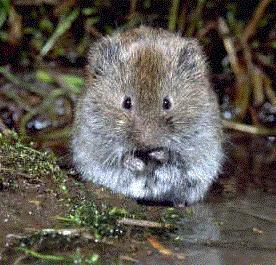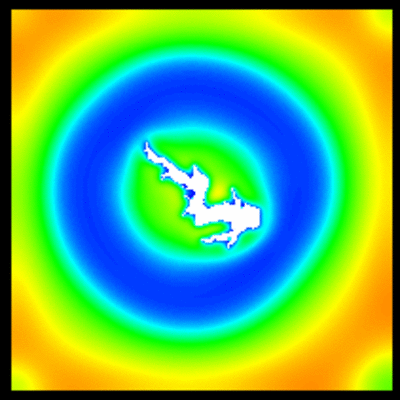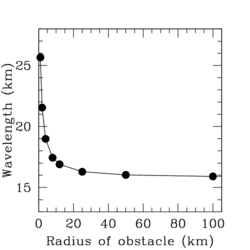Jonathan A. Sherratt, Department of Mathematics, Heriot-Watt University
Spatiotemporal Patterns of Cyclic Field Voles
Field voles in Kielder Forest
 Kielder Forest is a large area of managed woodland on the border
between Scotland and England. The forest is a good habitat for field
voles (Microtus agrestis), and this population cycles with a
period of about 4 years. Detailed spatiotemporal field studies show
that the vole cycles are not synchronous in space; rather, they are
out of phase in different parts of the forest, and are organised into
a periodic travelling wave. Thus bands of high and low vole density
move across the forest; the speed of movement is 15-20 km per year.
Kielder Forest is a large area of managed woodland on the border
between Scotland and England. The forest is a good habitat for field
voles (Microtus agrestis), and this population cycles with a
period of about 4 years. Detailed spatiotemporal field studies show
that the vole cycles are not synchronous in space; rather, they are
out of phase in different parts of the forest, and are organised into
a periodic travelling wave. Thus bands of high and low vole density
move across the forest; the speed of movement is 15-20 km per year.
Wave generation by Kielder Water
A key question arising from this field data is: what causes the
waves to form? One potential explanation is suggested by the geography
of the forest. At its centre is a large (10 square km) reservoir,
Kielder Water - one of the largest man-made bodies of water in
Europe. It is long and thin in shape, and the wave fronts found in the
vole data lie approximately parallel to the reservoir. This suggests
that the reservoir may explain the formation of the periodic waves.
 I have investigated this in collaboration with Tom Sherratt,
Xavier Lambin and Chris Thomas.
We assumed that the vole population cycles are
driven by the interaction with their main terrestrial predator,
weasels (Mustela nivalis). We show that in this type of
cyclic predator-prey system, large-scale landscape features such as
Kielder Water can generate periodic travelling waves.
The figure shows the periodic travelling wave that is generated in a
simulation of weasel-vole dynamics in Kielder Forest. The colours
indicate vole density (red=high, blue=low) and the "hole" in the
middle is a representation of Kielder Water. Move the mouse over the
image to see the effects of removing the reservoir: the vole density
gradually becomes uniform in space. This simple mathematical experiment
shows that it is the reservoir that is causing the periodic wave in
vole density.
I have investigated this in collaboration with Tom Sherratt,
Xavier Lambin and Chris Thomas.
We assumed that the vole population cycles are
driven by the interaction with their main terrestrial predator,
weasels (Mustela nivalis). We show that in this type of
cyclic predator-prey system, large-scale landscape features such as
Kielder Water can generate periodic travelling waves.
The figure shows the periodic travelling wave that is generated in a
simulation of weasel-vole dynamics in Kielder Forest. The colours
indicate vole density (red=high, blue=low) and the "hole" in the
middle is a representation of Kielder Water. Move the mouse over the
image to see the effects of removing the reservoir: the vole density
gradually becomes uniform in space. This simple mathematical experiment
shows that it is the reservoir that is causing the periodic wave in
vole density.
Periodic Wave Selection
 Equation systems such as our predator-prey model have a family of
periodic travelling wave solutions. Therefore it is natural to ask
what determines the particular wave that forms around a large scale
landscape feature such as Kielder Water.
I have investigated this
question in collaboration with Tom Sherratt and Xavier Lambin.We showed that travelling wave selection depends on the size and shape
of the landscape feature.
The figure opposite shows the variation in
wavelength with the radius of a cicular obstacle for parameter values
corresponding to the weasel-field vole interaction. Smaller obstacles
generate waves with longer wavelength.
For non-circular obstacles, our numerical studies show that it is the
largest linear dimension that is important. Thus for Kielder Water,
which long and thin, it is the length that controls periodic wave
selection.
Equation systems such as our predator-prey model have a family of
periodic travelling wave solutions. Therefore it is natural to ask
what determines the particular wave that forms around a large scale
landscape feature such as Kielder Water.
I have investigated this
question in collaboration with Tom Sherratt and Xavier Lambin.We showed that travelling wave selection depends on the size and shape
of the landscape feature.
The figure opposite shows the variation in
wavelength with the radius of a cicular obstacle for parameter values
corresponding to the weasel-field vole interaction. Smaller obstacles
generate waves with longer wavelength.
For non-circular obstacles, our numerical studies show that it is the
largest linear dimension that is important. Thus for Kielder Water,
which long and thin, it is the length that controls periodic wave
selection.
The work described on this page is discussed in the following papers:
-
J.A. Sherratt, X. Lambin, C.J. Thomas, T.N. Sherratt:
Generation of periodic waves by landscape features in cyclic
predator-prey systems.
Proc. R. Soc. Lond. B 269, 327-334 (2002).
Click to see the
 Full paper (PDF)
Full paper (PDF)
-
J.A. Sherratt:
Periodic travelling wave selection by
Dirichlet boundary conditions in
oscillatory reaction-diffusion systems.
SIAM J. Appl. Math. 63, 1520-1538 (2003).
Click to see the
 Full paper (PDF)
Full paper (PDF)
-
J.A. Sherratt, X. Lambin, T.N. Sherratt:
The effects of the size and shape of landscape features on the
formation of travelling waves in cyclic populations.
Am. Nat. 162, 503-513 (2003).
Click to see the
 Full paper (PDF)
and in a separate file, the
Full paper (PDF)
and in a separate file, the
 Online appendices (PDF)
Online appendices (PDF)
Back to Jonathan Sherratt's Research Interests
Back to Jonathan Sherratt's Home Page
 Full paper (PDF)
Full paper (PDF)
 Full paper (PDF)
Full paper (PDF)
 Full paper (PDF)
and in a separate file, the
Full paper (PDF)
and in a separate file, the
 Online appendices (PDF)
Online appendices (PDF)
 Kielder Forest is a large area of managed woodland on the border
between Scotland and England. The forest is a good habitat for field
voles (Microtus agrestis), and this population cycles with a
period of about 4 years. Detailed spatiotemporal field studies show
that the vole cycles are not synchronous in space; rather, they are
out of phase in different parts of the forest, and are organised into
a periodic travelling wave. Thus bands of high and low vole density
move across the forest; the speed of movement is 15-20 km per year.
Kielder Forest is a large area of managed woodland on the border
between Scotland and England. The forest is a good habitat for field
voles (Microtus agrestis), and this population cycles with a
period of about 4 years. Detailed spatiotemporal field studies show
that the vole cycles are not synchronous in space; rather, they are
out of phase in different parts of the forest, and are organised into
a periodic travelling wave. Thus bands of high and low vole density
move across the forest; the speed of movement is 15-20 km per year.
 I have investigated this in collaboration with Tom Sherratt,
Xavier Lambin and Chris Thomas.
We assumed that the vole population cycles are
driven by the interaction with their main terrestrial predator,
weasels (Mustela nivalis). We show that in this type of
cyclic predator-prey system, large-scale landscape features such as
Kielder Water can generate periodic travelling waves.
The figure shows the periodic travelling wave that is generated in a
simulation of weasel-vole dynamics in Kielder Forest. The colours
indicate vole density (red=high, blue=low) and the "hole" in the
middle is a representation of Kielder Water. Move the mouse over the
image to see the effects of removing the reservoir: the vole density
gradually becomes uniform in space. This simple mathematical experiment
shows that it is the reservoir that is causing the periodic wave in
vole density.
I have investigated this in collaboration with Tom Sherratt,
Xavier Lambin and Chris Thomas.
We assumed that the vole population cycles are
driven by the interaction with their main terrestrial predator,
weasels (Mustela nivalis). We show that in this type of
cyclic predator-prey system, large-scale landscape features such as
Kielder Water can generate periodic travelling waves.
The figure shows the periodic travelling wave that is generated in a
simulation of weasel-vole dynamics in Kielder Forest. The colours
indicate vole density (red=high, blue=low) and the "hole" in the
middle is a representation of Kielder Water. Move the mouse over the
image to see the effects of removing the reservoir: the vole density
gradually becomes uniform in space. This simple mathematical experiment
shows that it is the reservoir that is causing the periodic wave in
vole density.
 Equation systems such as our predator-prey model have a family of
periodic travelling wave solutions. Therefore it is natural to ask
what determines the particular wave that forms around a large scale
landscape feature such as Kielder Water.
I have investigated this
question in collaboration with Tom Sherratt and Xavier Lambin.We showed that travelling wave selection depends on the size and shape
of the landscape feature.
The figure opposite shows the variation in
wavelength with the radius of a cicular obstacle for parameter values
corresponding to the weasel-field vole interaction. Smaller obstacles
generate waves with longer wavelength.
For non-circular obstacles, our numerical studies show that it is the
largest linear dimension that is important. Thus for Kielder Water,
which long and thin, it is the length that controls periodic wave
selection.
Equation systems such as our predator-prey model have a family of
periodic travelling wave solutions. Therefore it is natural to ask
what determines the particular wave that forms around a large scale
landscape feature such as Kielder Water.
I have investigated this
question in collaboration with Tom Sherratt and Xavier Lambin.We showed that travelling wave selection depends on the size and shape
of the landscape feature.
The figure opposite shows the variation in
wavelength with the radius of a cicular obstacle for parameter values
corresponding to the weasel-field vole interaction. Smaller obstacles
generate waves with longer wavelength.
For non-circular obstacles, our numerical studies show that it is the
largest linear dimension that is important. Thus for Kielder Water,
which long and thin, it is the length that controls periodic wave
selection.
 Full paper (PDF)
Full paper (PDF)
 Full paper (PDF)
Full paper (PDF)
 Full paper (PDF)
and in a separate file, the
Full paper (PDF)
and in a separate file, the
 Online appendices (PDF)
Online appendices (PDF)